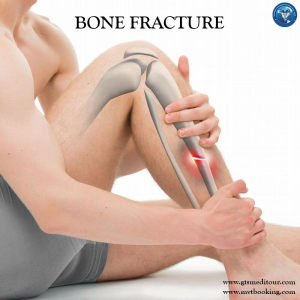DEFINITION
A bone fracture is a medical condition where the continuity of the bone is broken. A significant percentage of bone fractures occurs because of high force impact or stress. Also it may be due to cancers , osteogenesis imperfecta, osteoporosis etc…
TYPES
- Avulsion fracture- a muscle or ligament pulls on the bone, fracturing it
- Comminuted fracture- the bone is shattered into many pieces
- Compression (crush) fracture- generally occurs in the spongy bone in the spine
- Fracture dislocation – a joint becomes dislocated and one of the bones of joint has a fracture
- Greenstick fracture- the bone partly fractures on one side, but does not break completely because the rest of the bone can bend
- Hairline fracture- a partial fracture of the bone .Sometimes this type of fracture is harder to detect with routine x-ray
- Impacted fracture – when the bone is fractured , one fragment of bone goes into another
- Intra articular fracture- where break is along the length of the bone
- Oblique fracture- a fracture that is diagonal to a bones long axis
- Pathological fracture- when an underlying disease or condition has already weakened the bone, resulting in a fracture
- Spiral fracture- a fracture where at least one part of the bone has been twisted
- Tortus fracture- bone deforms but does not crack
- Transverse fracture- a straight break right across a bone
SYMPTOMS
The signs and symptoms of a fracture vary according to which bone is affected , the patients age and general health as well as the severity of injury. Some of the following are
- Pain
- Swelling
- Bruising
- Discolored skin around the affected area
- Angulation- affected area may be bent at an unusual angle
- Patient is unable to put weight on the injured area
- Patient cannot move the affected area
DIAGNOSIS AND TREATMENT
Bone healing is a natural process which in most cases well occur automatically. For the natural healing process to begin , the ends of the broken bone need to be lined up this is known as reducing the fracture. The patient is usually asleep under a general anesthesia when fracture reduction is done. Fracture reduction may be done by manipulation closed reduction or surgery.
Immobilization-as soon as the bones are aligned they must stay aligned while they heal
This may include
- Plaster casts or plastic functional braces- these hold the bone in position until it has healed
- Metal plates and screw – current procedures may use minimally invasive techniques
- Intra medullary nails- internal metal rods are placed down the center of long bone
- External fixators- these may be made of metal or carbon fiber , they have steel pins that go into the bone directly through the skin
- Healing – if a broken bone has been aligned properly and kept immobile , the healing process is usually straight forward
- Physical therapy- after the bone has healed , it may be necessary to restore muscle strength as well as mobility to the affected area
COMPLICATIONS
- Heals in the wrong position
- Disruption of bone growth
- Persistent bone or bone marrow infection
- Avascular necrosis or bone death
To get opinion from our network of hospitals visit www.mvtbooking.com or send email to query@gtsmeditour.com
Prepared by Dr Sajna Hamza


Post a comment